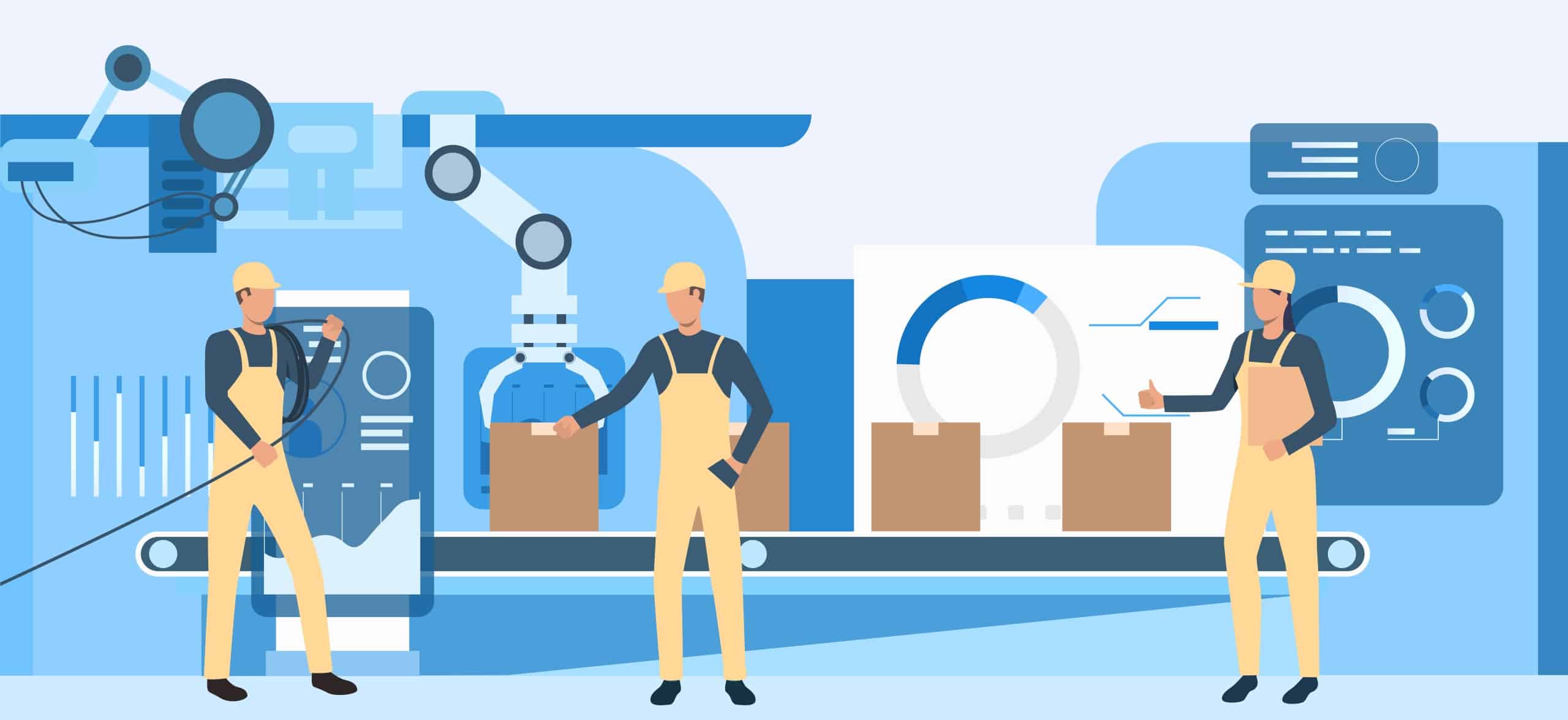Step 1: Assess Your Current Production Line
Before automating your wet wipes manufacturing line, it is important to have a comprehensive understanding of the existing condition of your operations. This entails doing a thorough examination of your current wet wipes manufacturing line. Commence by delineating the whole wet wipes manufacturing process, including the initial acquisition of wet wipes raw materials to the ultimate packing of wet wipes. Determine and specify each stage, the apparatus used, and the personnel necessary. Record the movement of materials and the interplay between various phases of manufacturing.
The main goal of this audit is to identify bottlenecks and inefficiencies that impede production. Identify the specific steps in the manufacturing process where delays often happen or where there is a high level of human intervention needed. These are prospective domains where automation can have a substantial influence. Tasks such as folding, cutting, and packing wet wipes are often repetitive and time-consuming, making them well-suited for automation.
Evaluate the state and efficiency of your existing equipment. Assess if they are compatible with emerging automation technologies or whether they need updating. Outdated machinery may not effectively interface with contemporary automated systems, requiring either partial or total replacement. Furthermore, take into account the existing technical infrastructure. Efficient automation necessitates the use of resilient IT systems to oversee and regulate diverse automated components properly.
Employ historical production data to get valuable insights into the efficiency and effectiveness of your wet wipes manufacturing line. Efficiency may be accurately measured by metrics such as production speed, mistake rates, downtime, and maintenance frequency. Examining this data enables you to comprehend the present production capacities and establish practical standards for the enhancements you anticipate from automation. This data-centric strategy guarantees that the shift towards automation is based on concrete performance measures rather than mere assumptions.
Engage your wet wipes manufacturing line personnel in the evaluation process. They often possess the most familiarity with the daily obstacles and inefficiencies. Their opinion may provide useful perspectives that may not be evident from a managerial standpoint. By actively involving your team, you may effectively equip them to adapt to forthcoming changes, minimize opposition to automation, and cultivate a cooperative atmosphere.
Thoroughly record all findings in detail after finishing the audit. This documentation provides a standard against which you may evaluate the effects of automation. Additionally, it aids in formulating a comprehensive integration strategy that specifically targets the highlighted areas of concern discovered during the audit. To optimize your automation approach and get optimal results, it is crucial to possess a comprehensive comprehension of your existing wet wipes production line.
To summarize, evaluating your existing production line is the fundamental stage in integrating automation. It offers a comprehensive assessment of your current position, highlights areas that need improvement, and paves the way for a smooth transfer to a more streamlined and updated wet wipes production line.
Step 2: Define Your Automation Objectives
It is crucial to establish precise and well-defined automation goals to incorporate automation into your wet wipes manufacturing process. Begin by ascertaining your objectives for using automation effectively. It is important for these objectives to follow your overall company strategy and to specifically tackle the main difficulties that were discovered during the evaluation of your present production line. Well-defined goals provide guidance and a structure for evaluating the effectiveness of your automation endeavors.
An often-pursued goal is to enhance the rate of production. Automation may greatly decrease the amount of time needed for a wide range of processes, including material handling and packing. By using automation for repetitive and time-consuming tasks, you may enhance the overall efficiency and productivity of your manufacturing line. This not only satisfies the increasing demand but also enables the extension of your product assortment without requiring more physical work.
Another crucial goal is to decrease labor expenses. Although there is an upfront cost associated with automation, it may result in significant cost reductions in the long run by reducing reliance on human labor. Automated systems can function continuously without interruptions, resulting in enhanced productivity and decreased production costs per unit. This might enhance the competitiveness of your wet wipes in the market, especially in price-sensitive categories.
Enhancing the uniformity and excellence of the product is an additional important goal. Automation can guarantee consistent production of wet wipes, minimizing variations and failures. Automated quality control systems can identify and rectify problems immediately, guaranteeing that only items that adhere to your quality requirements are released to the market. This may improve your brand’s reputation and increase consumer happiness.
Errors made by humans might result in expensive blunders and delays in manufacturing. By implementing automation for crucial procedures, you may reduce the likelihood of mistakes associated with human execution. Automated dispensing systems can guarantee the exact quantity of liquid is administered to each wipe, while robotic arms can carry out packing duties with unwavering precision. This minimizes waste and enhances overall efficiency.
Automation may enhance workplace safety and ergonomics as well. By substituting manual jobs that include strenuous lifting, repeated movements, or contact with dangerous substances, you may provide a more secure working environment for your staff. Automated solutions can assume control of these duties, therefore reducing the likelihood of accidents and enhancing the general job satisfaction of your personnel.
Another goal may be to improve the scalability and flexibility of your manufacturing line. Automated systems are very adaptable and may be readily adjusted to match production requirements, whether increasing or decreasing in size. Additionally, they may be reprogrammed to adapt to changing product requirements, enabling prompt response to market needs and fostering innovation with novel goods. The adaptability provided by this flexibility might provide you with a competitive advantage in a rapidly changing market.
To guarantee the achievement of your goals, it is essential to establish quantifiable key performance indicators (KPIs). These key performance indicators (KPIs) must possess characteristics of specificity, achievability, relevance, and time-bound nature. Examples include benchmarks for manufacturing velocity, defect ratios, labor cost mitigation, and safety occurrences. By consistently monitoring these Key Performance Indicators (KPIs), you can effectively assess the advancement of your automation initiatives and make informed choices based on data to enhance performance.
Ultimately, it is crucial to establish your automation goals as a fundamental stage in the process of integrating automation. Precise and unambiguous objectives will steer your approach, validate your expenditure, and provide standards for evaluating achievement. To guarantee that your automation efforts provide actual advantages for your wet wipes manufacturing line, it is crucial to concentrate on certain objectives such as heightened production speed, decreased labor costs, enhanced product quality, and better safety.
Step 3: Research Automation Technologies
After establishing your automation goals, the subsequent task is to do a study on the diverse automation technologies accessible in the industry. To comprehend the many automation options that may be implemented at different phases of your wet wipes manufacturing line, a comprehensive grasp is required. Technologies such as robotic arms, automated guided vehicles (AGVs), smart sensors, and sophisticated software systems provide many capabilities that may improve production and efficiency.
Robotic arms are well-suited for the automation of monotonous activities, such as the folding, cutting, and packing of wet wipes. These wet wipes machines can operate at high velocities with exceptional accuracy, resulting in a considerable reduction in the time and effort needed for these activities. Moreover, robotic arms can function continually without experiencing weariness, therefore guaranteeing a consistent level of output quality. Investing in robotic technology may optimize your manufacturing process, save labor expenses, and enhance product uniformity.
AGVs are self-driving vehicles specifically built to transport items inside a manufacturing plant. These vehicles can transport raw materials, semi-finished products, and completed items efficiently, hence minimizing the need for physical material handling. By using Automated Guided Vehicles (AGVs), you may streamline the movement of materials throughout your manufacturing line, reduce periods of inactivity, and improve overall operational effectiveness. Automated Guided Vehicles (AGVs) are especially valuable in expansive industrial facilities where the movement of materials plays a crucial role in the production workflow.
Smart sensors are essential in contemporary automation since they provide real-time data on many elements of the wet wipes manufacturing process. The sensors can monitor temperature, humidity, pressure, and other essential characteristics to guarantee the most favorable manufacturing circumstances. In addition, they can identify irregularities and initiate notifications or remedial measures automatically. By incorporating intelligent sensors into your wet wipes manufacturing process, you can optimize quality assurance, minimize inefficiencies, and raise the overall standard of your products.
Advanced software systems are necessary for the management and regulation of automated wet wipes manufacturing lines. These systems can include several automation technologies, creating a consolidated platform for overseeing and managing the whole wet wipes production process. Their offerings include predictive maintenance, real-time data analytics, and remote monitoring, allowing for continual optimization of operations. By using sophisticated software, you may get enhanced command over your manufacturing operations and promptly address any arising concerns.
When researching automation technologies, it is essential to assess their compatibility with your current production line. Certain technologies may need substantial alterations to your existing configuration, but others may be effortlessly included. Take into account the scalability, adaptability, and compatibility of the technology you are evaluating. Make sure that the selected solutions are in line with your long-term automation goals and can be readily updated as your requirements change.
The area of automation is in a constant state of evolution, with frequent emergence of new technologies and breakthroughs. Keeping up with industry developments and improvements will enable you to make well-informed judgments on your automation investments. Stay updated on the latest advancements by attending industry conferences, engaging in webinars, and subscribing to pertinent periodicals. Engaging in networking activities with industry professionals and peers may provide significant insights and suggestions.
When researching automation technologies, it is crucial to take into account the cost and prospective return on investment (ROI). Implementing automation may need a substantial initial financial commitment, but the enduring advantages, such as enhanced efficiency, reduced labor expenses, and enhanced product excellence, often justify the spending. Perform a comprehensive cost-benefit analysis to ascertain the return on investment (ROI) for each technology under consideration. Seek solutions that provide optimal cost-effectiveness, functionality, and scalability.
Seeking advice from automation specialists might provide helpful insight during the research stage. These experts can evaluate your requirements, suggest suitable technology, and assist you in formulating a full automation plan. With their knowledge, they can help you choose the most appropriate technology for your production line and prevent frequent challenges that come with implementing automation.
To summarize, researching automation technologies is an essential measure in incorporating automation into your wet wipes manufacturing process. To make well-informed judgments that correspond with your automation goals, you should explore the various technologies, assess their compatibility, remain updated on industry trends, and analyze the cost and return on investment (ROI). By using appropriate technology, you may optimize productivity, save expenses, and increase the overall quality of your wet wipes manufacturing process.
Step 4: Develop a Detailed Integration Plan
Creating a comprehensive integration strategy is essential for the smooth integration of automation into your wet wipes manufacturing line. Begin by developing a thorough plan that delineates every step of the integration process. The plan should have specific timeframes, allocation of resources, and significant milestones. An organized and methodical strategy guarantees that all team members agree and are well-informed about their duties, hence minimizing the chances of any interruptions occurring during the execution stage.
Dividing the integration process into achievable milestones and deliverables helps in monitoring progress and sustaining momentum. Key milestones refer to significant events or stages in a project, such as the completion of early evaluations, acquisition of automation equipment, installation phases, and testing periods. Allocate specific tasks or objectives to each milestone to guarantee measurable progress at each stage. This methodical approach ensures that the project adheres to the planned timeline and enables prompt modifications in case of any complications.
Efficient distribution of resources is a crucial component of the integration strategy. Determine the necessary staff, machinery, and financial assets needed for every stage of the project. Make sure you have a specialized project team with well-defined roles and duties. Create a practical budget that encompasses all costs, such as procurement of equipment, acquisition of software licenses, participation in training programs, and allocation of cash for unexpected obstacles. Effective allocation of resources and careful budget planning are essential to avoid delays and maintain the financial sustainability of the project.
Developing an accurate timeframe is crucial for achieving effective integration. Calculate the length of each step and establish realistic time limits. Take into account variables such as the time it takes for equipment to be delivered, the duration of the installation process, and the timing of training sessions. An explicitly stated timeframe helps in the management of expectations and ensures that the project stays on schedule. Frequently assess the timeframe to accommodate any modifications or delays and make any adjustments to the strategy.
Implementing automation might include a range of hazards, including technological complexities, equipment failures, and opposition from employees. Early in the planning phase, it is important to identify possible risks and create methods to minimize or eliminate them. Develop a contingency plan that delineates the necessary actions to be implemented in the event of any substantial problems. By adopting a proactive strategy, you may effectively anticipate and address unforeseen challenges, therefore mitigating their influence on the project.
Efficient and clear communication with all individuals involved is crucial for the successful implementation of the integration strategy. Interact with management, workers, suppliers, and other important stakeholders to ensure they are updated on the project’s progress and objectives. Effective and unambiguous communication fosters trust and guarantees alignment among all parties involved. Frequent updates, meetings, and feedback sessions promote a cooperative atmosphere and stimulate stakeholder engagement.
Gradually implementing automation enables a more seamless transition and mitigates the potential for interruptions. Commence with a first phase in which you implement automation for a certain segment of the manufacturing line. Supervise its effectiveness, collect input, and implement required modifications before expanding to more regions. This incremental method facilitates the early detection of possible problems and allows for the refinement of the system. Additionally, it enables staff to gradually acclimate to the new technology.
Training is an essential element of the integration strategy. Create an all-encompassing training program to guarantee that your staff is skilled in running and maintaining the newly implemented automated systems. Offer practical training sessions, comprehensive user manuals, and ongoing assistance to resolve any inquiries or issues. Having a knowledgeable and proficient staff is crucial for optimizing the advantages of automation and guaranteeing a seamless transition.
After integrating the automation systems, build a procedure for ongoing monitoring and assessment. Utilize the key performance indicators (KPIs) established in your goals to gauge the effectiveness of the automation deployment. Consistently analyze performance data, identify areas that need enhancement, and implement appropriate modifications to optimize the system. Continuous review guarantees that the automation consistently produces the intended outcomes and is in line with your company’s objectives.
Ensure comprehensive documentation of the integration process, including meticulous records of every step, choices taken, and results attained. This documentation acts as a great resource for future automation initiatives and helps in resolving any difficulties that may occur. Consistently providing updates to stakeholders ensures that they are kept up-to-date on the project’s advancements and achievements, therefore strengthening their trust in the automation program.
To summarize, creating a comprehensive integration strategy is an essential component in effectively implementing automation in your wet wipes manufacturing process. An intricately designed strategy with distinct benchmarks, allocation of resources, mitigation of risks, and efficient communication guarantees a seamless transition and optimizes the advantages of automation. By adhering to a methodical and sequential strategy, you may successfully attain your automation goals and improve the effectiveness and output of your wet wipes manufacturing process.
Step 5: Choose the Right Automation Partner
Selecting the appropriate automation collaborator is a crucial choice that may greatly impact the effectiveness of incorporating automation into your wet wipes manufacturing process. A proficient and trustworthy collaborator can provide the knowledge, assistance, and advanced tools necessary to accomplish your automation goals rapidly. An ideal partner would not only provide the required equipment, but also provide extensive services, such as advice, installation, training, and continuous maintenance.
Initiate your hunt by assessing the proficiency and background of possible automation collaborators. Seek for wet wipes machine manufacturers with a demonstrated history of success in the wet wipes manufacturing industry or related fields. A seasoned collaborator will possess an extensive comprehension of the particular obstacles and prerequisites of your producing procedures. They can provide customized solutions that specifically target your requirements and guarantee a seamless transition to automation.
Solicit case studies and references from potential partners to assess their competencies and track records. Examining case studies may provide valuable insights into the effective implementation of automation systems for previous customers. Engage in conversations with past clientele to get insights into their experiences, including the caliber of service, dependability of the equipment, and the efficacy of the solutions provided. Positive comments and successful case studies serve as robust markers of a reliable partner.
Evaluate the variety of technology and solutions provided by each possible partner. Make sure that they provide cutting-edge automation equipment that is in line with your production objectives. Seek partners who provide a wide range of technology, such as robotic arms, AGVs, intelligent sensors, and innovative software systems. Their capacity to provide comprehensive solutions shows their proficiency in managing the full automation process without any disruptions.
Each wet wipes manufacturing line has distinct needs, and using a standardized technique may not provide optimal results. Select a partner that can tailor their solutions to meet your requirements. The customization possibilities include the ability to adapt equipment settings, integrate software, and automate operations to align with your specific production processes. An alliance with a partner that can provide customized solutions will guarantee the smooth integration of the automation system with your current operations.
Continued assistance and upkeep are essential for ensuring the enduring prosperity of your automation investment. Assess the assistance services provided by prospective partners, including instructional initiatives, technological assistance, and maintenance agreements. Ensure that they provide timely and dependable assistance to resolve any post-implementation concerns. Having a reliable support infrastructure from a partner may effectively reduce downtime and ensure the continuous operation of your wet wipes manufacturing line.
Although cost should not be the only determining element, it is crucial to take into account the financial aspect of collaborating with an automation supplier. Inquire for comprehensive quotations and do a thorough cost analysis of equipment, installation, and continuing support services. Perform a cost-benefit analysis to ascertain the probable return on investment (ROI). Choosing a partner that provides price information that is easy to understand and shows a certain return on investment might assist you in making a well-informed choice.
Verify that the prospective automation collaborators adhere to industry norms and possess the required credentials. Adhering to regulatory regulations and industry standards guarantees that the equipment and solutions offered are secure, dependable, and of superior quality. Certifications also demonstrate that the partner follows industry standards in production and service delivery.
Efficient communication and cooperation are crucial for a productive relationship. Evaluate the communication style and level of response of prospective partners throughout the assessment phase. An attentive partner who actively addresses your requirements, swiftly replies, and closely cooperates with your team may greatly improve the implementation process. Effective communication ensures that any obstacles are swiftly handled and that the project remains on schedule.
Take into account the possibility of establishing a durable collaboration with the automation supplier. Automation is a perpetual process that needs constant refinement and enhancements. A dedicated partner who is devoted to establishing a lasting relationship may provide essential assistance as your manufacturing requirements develop over time. Seek for partners that have a strong commitment to supporting your achievements and provide sustainable solutions.
To summarize, selecting the appropriate automation collaborator is a crucial step in incorporating automation into your wet wipes manufacturing process. To achieve a successful automation journey, it is important to evaluate the experience, technology solutions, support services, customization capabilities, and long-term partnership possibilities of possible partners. A dependable and knowledgeable collaborator will provide the basis for attaining improved efficiency, productivity, and product quality in your wet wipes manufacturing procedures.
Step 6: Invest in Training and Skill Development
Training and skill development are crucial for effectively incorporating automation into your wet wipes manufacturing line. Automation technologies can improve productivity, efficiency, and product quality greatly. However, to fully reap these advantages, it is crucial to ensure that your crew is properly educated to operate and maintain these systems. Thorough training guarantees that your personnel has the necessary skills to proficiently use the new technology, resulting in decreased periods of inactivity, fewer mistakes, and more profitability from your automation investment.
The first phase involves developing an all-encompassing training program that is customized to meet the unique requirements of your wet wipes manufacturing line. This curriculum aims to comprehensively address all facets of the new automation systems, including operating procedures, problem-solving, and maintenance. Divide the instruction into modules that tackle various degrees of complexity, ranging from fundamental procedures to advanced technical abilities. By offering systematic and incremental training, personnel may develop their skills and self-assurance in using the automated systems.
Practical training is essential for efficient knowledge acquisition. Enable staff to get hands-on experience with the new equipment while being closely monitored by expert trainers. Gaining practical, hands-on experience enables individuals to grasp the intricacies of the technology and its seamless integration with current operations. Moreover, the use of simulations may provide a safe and secure setting for workers to engage in practice and explore various situations without any potential risks. Simulations aid in comprehending future problems and acquiring the knowledge to address them without adversely affecting real-time output.
Automation technologies are always progressing, and it is crucial to keep up with the newest innovations. Foster a culture of perpetual learning and growth inside your business. Provide recurring training sessions, workshops, and seminars to ensure that your personnel is informed about the latest features, optimal methods, and current trends in the business. Motivate personnel to actively seek certifications and engage in further education about automation and manufacturing technology. Ongoing education guarantees that your staff stays skilled in using the most recent innovations to sustain a competitive advantage.
Utilize the knowledge and skills of your automation collaborator to create and implement training programs. Several automation companies provide extensive training services as part of their implementation package. Engage in collaboration with them to guarantee that the training material remains relevant and current. Their expertise and wisdom may provide useful perspectives and elevate the quality of your training sessions. In addition, it is advisable to have their specialists present at the location during the first stages of implementation to provide practical direction and assistance.
Promote cross-training to guarantee that many staff has expertise in running and maintaining the automated systems. Cross-training enhances redundancy, hence reducing dependence on a single person for essential functions in your manufacturing line. Furthermore, it fosters a workforce that is adaptable and multifaceted, capable of seamlessly transitioning between various tasks as required. By diversifying their skills, your staff will be equipped to manage several facets of the wet wipes manufacturing process, including equipment operation, quality control, and problem-solving.
Consistently assess and appraise the efficacy of your training initiatives. Evaluate the influence of training on performance by using indicators such as mistake rates, production efficiency, and employee feedback. Implement regular evaluations and recurrent training sessions to strengthen knowledge retention and rectify any deficiencies. Continuous assessment facilitates the identification of areas for development and guarantees that your training programs adapt to suit evolving demands and technological improvements.
Allocating resources towards training and skill development not only improves operational efficiency but also empowers your personnel. Facilitating avenues for professional advancement and progress enhances employee morale and work contentment. Employees who see themselves as appreciated and competent are more inclined to adopt automation and have a constructive impact on its achievements. Employees who are empowered are also more proactive in recognizing and resolving issues, resulting in ongoing improvement and innovation in their production processes.
Automation has the potential to greatly enhance workplace safety by minimizing the need for physical labor in dangerous operations. Nevertheless, it also brings up novel safety concerns associated with the operation and upkeep of sophisticated gear. Integrate thorough safety training into your program to guarantee that staff possesses a clear understanding of how to engage with automated systems properly. The training program should include instruction on emergency procedures, safety regulations, and the correct use of personal protective equipment (PPE). An emphasis on safety guarantees a secure work environment and reduces the likelihood of accidents and injuries.
Ensure comprehensive documentation of all training procedures, resources, and sessions. This paperwork is an invaluable resource for future training and onboarding of new staff. It guarantees uniformity in the delivery of training and serves as a point of reference for workers to review when necessary. Thoroughly documented training methods also enable ongoing improvement by enabling you to monitor modifications, updates, and comments over some time.
Ultimately, including training and skill enhancement is an essential measure for effectively integrating automation into your wet wipes manufacturing process. An adequately skilled staff is crucial for optimizing the advantages of automation, improving productivity, and guaranteeing operational efficiency. To enable your staff to properly use automation technology and achieve long-term success in your manufacturing processes, it is crucial to provide extensive training programs, encourage continual learning, and prioritize safety.
Step 7: Implement Automation in Phases
Adopting a phased implementation of automation is a smart method that facilitates a seamless transition and reduces the likelihood of delays to your wet wipes manufacturing line. Instead of completely revamping the whole system all at once, a phased implementation divides the work into smaller, more manageable parts. This systematic approach facilitates the early detection of possible problems, enables the workforce to adjust gradually, and supports ongoing improvement throughout the implementation process.
Commence by implementing a pilot phase in which you mechanize a certain segment of your manufacturing process. Select an area that has the potential to benefit the most from automation, such as a bottleneck that has been discovered during your first evaluation. The pilot phase functions as an experimental platform for the new technology, enabling you to assess its performance inside a regulated setting. Collect statistics on enhancements in efficiency, decrease in errors, and the overall influence on production. This information will be very important in improving the automated process before a wider rollout.
Throughout the pilot period, diligently observe and evaluate the efficiency of the automated system. Monitor and measure important performance metrics, such as the pace at which production is completed, the frequency of errors, the amount of time equipment is not in operation and the need for maintenance. Analyze this data to detect any problems or inefficiencies. Be ready to modify the system, procedures, or training as necessary. The objective is to enhance the automated system to guarantee its seamless and efficient operation. Ongoing monitoring and modification throughout this phase aid in reducing risks and improving the performance of the system.
After the successful completion of the pilot phase and the establishment of an effective automated system, proceed to progressively extend the automation to further sections of the production line. Gradually introduce automation by focusing on certain sections at a time. By following a systematic and gradual process, your team can effectively adjust to the changes and minimize the chances of significant interruptions. It is important to subject each subsequent step to the same amount of careful examination and refinement as the pilot phase, to achieve consistent enhancements across the whole wet wipes manufacturing process.
Ensuring the active participation and involvement of your personnel throughout each stage of the implementation process is essential for achieving success. Ensure that personnel are regularly updated on the advancements and advantages of automation. Offer supplementary instruction and assistance as new stages are implemented. Engaging your staff in the implementation process cultivates a feeling of ownership and diminishes opposition to change. Employees who comprehend the significance of automation and possess a strong sense of confidence in their capacity to run the novel technology are more inclined to make constructive contributions to the shift.
Following the implementation of each level of automation, do a comprehensive review to gauge its effect. Conduct a comparison between the performance data and the baseline parameters that were set during the first evaluation. Identify the domains in which the automated system has shown exceptional performance and the domains that need more enhancements. Utilize this input to enhance and perfect the subsequent stage of execution. Periodic assessments guarantee that each stage capitalizes on the achievements of the preceding one, resulting in ongoing improvement and optimum efficiency.
Ensure comprehensive documentation is maintained at every stage of the implementation process. Record the procedures followed, difficulties faced, remedies implemented, and results achieved. This documentation acts as a vital reference for subsequent stages and serves as a record of optimal methods. Additionally, it promotes the exchange of information inside your firm and guarantees that valuable insights are not forgotten. Thorough documentation enhances a methodical and replicable approach to automation.
Employ data analytics to get more profound insights into the efficiency of the automated systems. Advanced analytics can uncover patterns, trends, and anomalies that may not be readily evident. By using data analytics, you may make well-informed selections about further enhancements and refinements. Predictive analytics may also aid in forecasting maintenance requirements and mitigating unforeseen periods of inactivity, guaranteeing the continuous efficiency and productivity of your manufacturing line.
When implementing automation gradually, ensure that you prepare for scalability to support future expansion. Make sure that the automated systems and procedures you implement can adapt and expand as needed. This progressive strategy enables you to increase your production capacity without substantial interruptions or extra expenditures. Scalable automation systems provide the flexibility to adapt to evolving market needs and sustain a competitive advantage.
During the gradual implementation process, provide effective communication of the accomplishments and advantages attained at every level. Emphasizing favorable results, such as enhanced effectiveness, fewer mistakes, and financial savings, strengthens the importance of automation to your stakeholders. Frequent updates about progress and accomplishments foster trust and support for the automation program. Commending significant achievements and reaching important goals also catalyzes motivating your team and fostering ongoing dedication to the project.
Ultimately, gradually adopting automation is a wise approach that guarantees a seamless shift and optimizes the advantages of automation. To optimize each step of the process, it is advisable to begin with a pilot phase, closely monitor performance, actively include your workers, and progressively increase automation. Continuous assessment, record-keeping, and data analysis contribute to continual enhancement and expandability, resulting in a more streamlined, efficient, and competitive wet wipes manufacturing process.
Step 8: Monitor and Optimize
Following the integration of automation into your wet wipes production line, it is essential to monitor the system to guarantee optimal performance consistently. Continuously track crucial data, referred to as key performance indicators (KPIs), such as production speed, error rates, times of inactivity, and maintenance needs. Monitoring this data provides instant observations on the system’s effectiveness and efficiency. By regularly monitoring performance data, you may instantly identify any deviations from expected results and take corrective actions before they become significant issues.
Data analytics plays a crucial role in the monitoring process. Utilize predictive analytics and machine learning algorithms to analyze large volumes of data generated by automated systems. These technologies can identify and examine patterns, trends, and potential concerns that may not be immediately apparent. Predictive maintenance leverages data to forecast equipment faults in advance, facilitating proactive maintenance and reducing unforeseen times of idleness. By using modern analytics, you can make educated decisions based on data-driven insights, therefore enhancing overall production efficiency.
Establish a methodical timetable for carrying out regular performance assessments. Conduct periodic evaluations to examine the performance of the automated systems about the initial metrics established during the first evaluation. During these assessments, include key stakeholders, such as executives, technical people, and operators, to get comprehensive information. Performance reviews provide an opportunity to recognize accomplishments, address challenges, and consider potential improvements. They ensure that the automation system aligns with your production goals and objectives.
Execute a plan for ongoing enhancement to optimize the effectiveness of the automated production line. Foster a culture of ongoing enhancement where employees are motivated to identify areas for improvement and provide solutions. Employ methodologies such as Lean, Six Sigma, or Kaizen to systematically analyze processes, minimize inefficiencies, and enhance productivity. Continuous development ensures that your production line remains agile and responsive to changing market demands, technological advancements, and operational challenges.
Staying updated with the latest technical advancements is crucial to maintain the efficiency of your automated systems, as technology advances rapidly. Continuously assess and assess new automation technologies, software upgrades, and equipment enhancements that might enhance the efficiency of your production line. Engage in close collaboration with your automation partner to evaluate the feasibility and benefits of integrating new technologies. By implementing updates and enhancements to your technology, you can ensure that your production line remains at the forefront of technological breakthroughs, enabling you to maintain a competitive advantage by using the latest innovations.
Ongoing training and support for your employees are essential as automation technologies and processes progress. Ensure that workers get frequent updates about new features, functionality, and best practices. Offer refresher classes and advanced training sessions to guarantee that their skills stay competent and up-to-date. By consistently offering training and support, staff members can adapt to changes effortlessly and ensure their competence in efficiently operating and maintaining the automated systems.
Optimization involves not just the automated equipment, but also the whole processes and procedures of your production line. Analyze the interaction between automated and human operations to find areas of congestion and inefficiency. Streamline operations to ensure seamless integration across several production phases. Optimizing processes involves enhancing the efficiency and effectiveness of scheduling, material handling, inventory management, and quality control systems. A comprehensive optimization approach ensures that the whole production line operates at its peak efficiency.
The efficacy of the automated manufacturing line is greatly contingent upon the involvement of your personnel. Regularly solicit feedback from employees who interact with the automated systems daily. Their observations may provide valuable data on practical challenges, usability issues, and prospects for improvement. Act upon this feedback to implement necessary revisions and enhancements. Involving employees in the optimization process fosters a collaborative environment and ensures that the automation system meets their needs and enhances their productivity.
Assess the efficiency of your production line by comparing it to well-established benchmarks and optimal methods used in the industry. Examining your key performance indicators (KPIs) in comparison to those of leading companies in the wet wipes manufacturing sector may provide significant insights into your strengths and areas requiring improvement. Industry benchmarks serve as a reference point for setting performance targets and identifying opportunities for future development. To ensure that your production line remains competitive and performs at its highest level of efficiency, it is important to strive to meet or exceed the industry standards actively.
Document the most efficient techniques and valuable knowledge acquired while overseeing and enhancing performance. Sharing this knowledge across your organization cultivates a culture of continuous learning and improvement. Create a centralized repository that has detailed documentation on procedures, troubleshooting tips, and optimization strategies. This repository should be easily available to all team members. Ensuring the documentation and widespread distribution of the most efficient techniques ensures that successful strategies are replicated and that the organization benefits from the collective knowledge.
Managing and improving the effectiveness of your automated wet wipes production system is an ongoing effort that requires attention, making educated decisions based on data, and a commitment to continuous development. To optimize the efficiency of your production line, it is advisable to use advanced analytics, consistently assess performance, enhance technology, and simplify operations. To enhance the effectiveness of your automated system, it is crucial to provide ongoing training and support, gather employee input, benchmark performance against industry norms, and document optimal procedures. By adopting continuous monitoring and optimization, you can ensure that you fully use the benefits of automation, so maintaining a competitive edge in the market and achieving long-term operational excellence.









